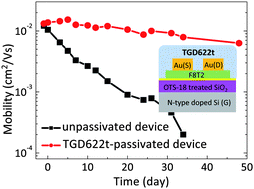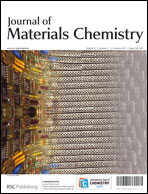In an effort to realize organic field-effect transistors (OFETs) that are stable over long periods of time, we have designed an organic–inorganic hybrid passivation material (TGD622t) prepared via a non-hydrolytic sol–gel process that does not require the use of solvents. Fourier-transform infrared spectroscopy, atomic force microscopy, and UV-visible spectroscopy demonstrated the high density and low porosity of the organic–inorganic hybrid transparent TGD622t film after low-temperature curing (below 100 °C). The dense TGD622t passivation layer, which exhibited a water vapor transmission rate (WVTR) of 0.434 g m−2 per day, effectively protected the poly[9,9-dioctylfluorenyl-2,7-diyl]-co-(bithiophene)]-based OFETs from humidity and oxygen in ambient air, resulting in a much more robust OFET performance with long-term stability relative to the operation of unpassivated devices.
You have access to this article
 Please wait while we load your content...
Something went wrong. Try again?
Please wait while we load your content...
Something went wrong. Try again?


 Please wait while we load your content...
Please wait while we load your content...